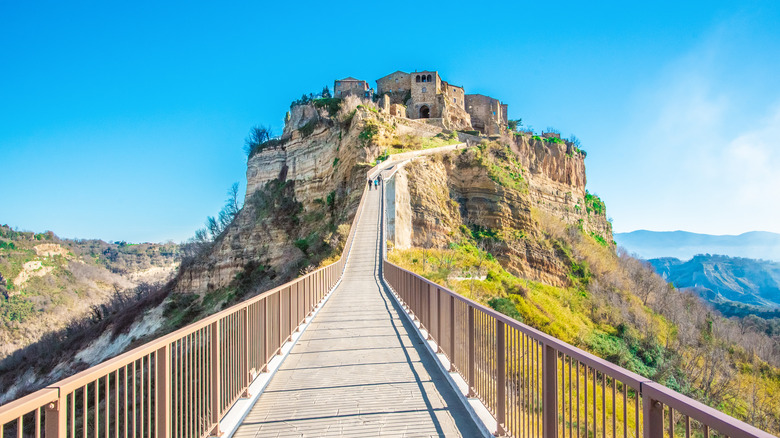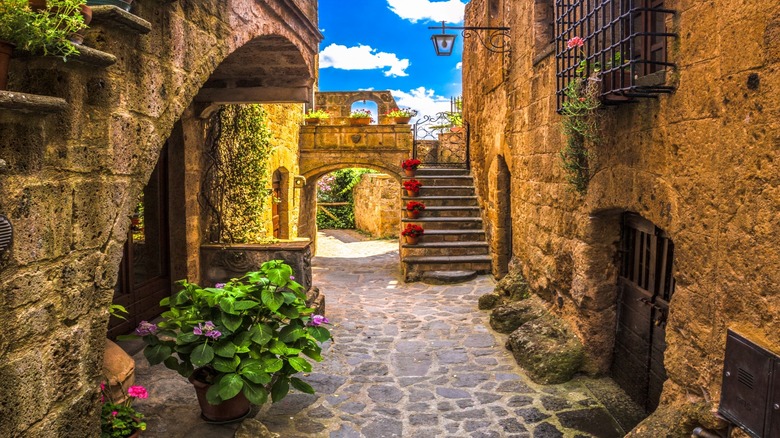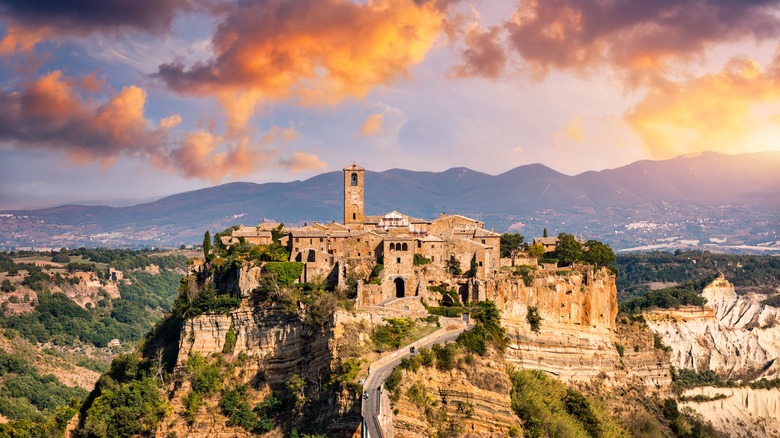Rick Steves’ absolute favorite European country is loaded with hill towns, each with its own distinct delights and characteristics. In Tuscany, Italy, there’s Sam Gimignano, for example. An hour’s drive from Florence, San Gimignano feels a bit touristy, but its well-preserved medieval towers make it the “epitome of a Tuscan hill town,” says Steves in his blog. If you like your hill towns by the seaside, Italy has those, too. Taormina in Sicily not only overlooks a beautiful stretch of ocean but also boasts impressive views of Europe’s largest active volcano, Mt. Etna.
In Rick Steves’ opinion, though, one hill town stands out above all the rest — Civita di Bagnoregio, officially declared a “borgho più bello d’Italia,” one of the most beautiful villages in Italy. But this is not just your everyday picturesque enclave. This one is perched atop its own formidable but highly unstable bluff, chunks of which occasionally fall off into the gorge, taking parts of the town with them. Civita di Bagnoregio’s uncertain geological future even earned it the nickname “la città che muore,” or “the dying village.” But morbid monikers aside, there’s a lot to love about this persevering little village, at least according to Rick Steves.
The magic of Civita di Bagnoregio

The only way to reach Civita di Bagnoregio is by walking from a nearby town along a 1,000-foot suspension bridge connected to the bluff. The bridge leads to an enormous passageway in the rock, which the Etruscans carved around 2,500 years ago. Passing through the village’s only remaining gate, Porta Santa Maria, “you enter another world — one stuck in the Middle Ages,” Steves notes in his blog. “You can feel the history in the smooth cobblestones under your feet.”
Bucket-listers won’t find much to do in these parts. But what Civita di Bagnoregio lacks in priceless statues and glittering monuments, it makes up for in cats (felines outnumber humans in the town by almost two to one) and in pure Italian essence, according to Steves. For him, the best way to appreciate this essence is to stroll along the town’s narrow roads and notice the small details: the graceful arches, the golden light hitting the stone walls, the carefully arranged flower pots along the terraces and stairways…
Take your experience of the town a step further, suggests Steves, and interact with residents on the street, even if it’s just to say “buongiorno” or “buona sera.” Notice how the visiting children still run around outside in the lighted piazza, deep into the night. The simple beauty of this place, its people, and their ways is a reminder that while time marches on, some of the sweetest aspects of human life are unchanging, at least in Civita di Bagnoregio.
Explore the town’s ancient past

While soaking up the town’s timeless ambiance, spend some moments in the main square, where you’ll find the unassuming Church of San Donato. St. Peter’s Basilica it is certainly not, but this place of worship has been around a long time, having been an Etruscan temple and then a Roman temple before becoming a Catholic church. It contains a few simple treasures, such as beautiful frescoes and a wooden crucifix from the 15th century. At the back of the church, a small alley leads to some Etruscan caves, called the Antica Civitas, which have been converted into a small museum (entry is 1 euro or around $1.10) depicting scenes of daily life in a home in the village. Kids will appreciate that parts of an old Pinocchio movie were filmed in these caves; some old puppets are still on display in the museum.
The only way to access Civita di Bagnoregio is to pay a small fee of 5 euros (around $5.40) and cross the bridge that connects the village with the nearby town of Bagnoregio. Note that a special transport service is available on Saturdays and Sundays for people with disabilities who are unable to make the trek across the bridge. The best way to reach Bagnoregio is by car, driving south from Florence (110 miles) or north from Rome (78 miles). Given its proximity to the Eternal City, Civita di Bagnoregio makes for an excellent day trip if you’re staying in Rome.

